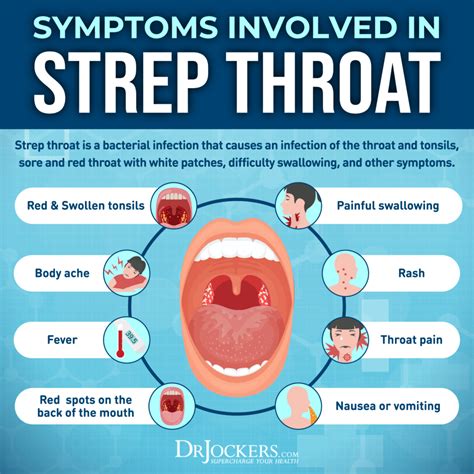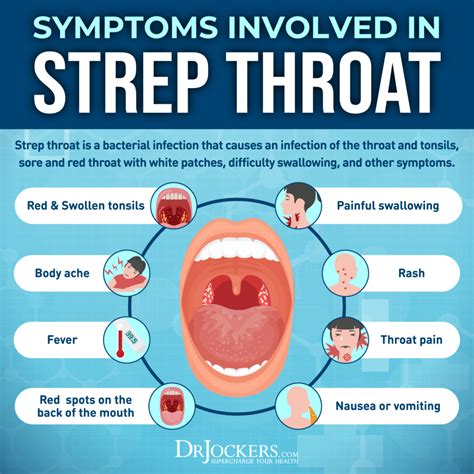Intro
Identify strep throat symptoms with 5 key methods, including sore throat signs, fever diagnosis, and rapid testing, to determine if you have strep infection or viral pharyngitis.
Strep throat, also known as streptococcal pharyngitis, is a highly contagious infection caused by the Streptococcus pyogenes bacteria. It affects millions of people worldwide, particularly children and young adults. Recognizing the symptoms and understanding the diagnosis and treatment options are crucial to prevent complications and reduce the risk of transmission. In this article, we will delve into the world of strep throat, exploring its causes, symptoms, diagnosis, treatment, and prevention.
The importance of understanding strep throat cannot be overstated. If left untreated, strep throat can lead to serious complications, such as kidney inflammation, rheumatic fever, and abscesses. Furthermore, strep throat can have a significant impact on daily life, causing missed school or work days, and disrupting social and family activities. By learning more about strep throat, individuals can take proactive steps to protect themselves and their loved ones from this highly contagious infection.
Strep throat is often mistaken for a sore throat caused by a viral infection, which can make diagnosis challenging. However, there are distinct symptoms and signs that can indicate the presence of strep throat. A thorough understanding of these symptoms and signs is essential for prompt diagnosis and treatment. In the following sections, we will explore the causes, symptoms, diagnosis, treatment, and prevention of strep throat, providing readers with a comprehensive guide to navigating this complex topic.
Understanding Strep Throat

Causes of Strep Throat
The causes of strep throat can be summarized as follows: * Close contact with an infected person * Touching surfaces contaminated with the bacteria * Inhaling respiratory droplets produced by an infected person * Poor hygiene and lack of handwashingRecognizing the Symptoms of Strep Throat

Distinguishing Strep Throat from Viral Sore Throat
It is essential to distinguish strep throat from a viral sore throat, as the treatment and prevention strategies differ. The following factors can help differentiate between the two: * Onset of symptoms: Strep throat symptoms tend to develop rapidly, while viral sore throat symptoms may develop gradually. * Severity of symptoms: Strep throat symptoms are often more severe than viral sore throat symptoms. * Presence of white patches: White patches on the tonsils are more commonly associated with strep throat.Diagnosing Strep Throat

Throat Swab Test
The throat swab test is a quick and relatively painless procedure that involves: * Gently swabbing the throat with a cotton swab * Sending the swab to a laboratory for analysis * Receiving the test results, which can take several minutes to several hoursTreating Strep Throat

Antibiotic Treatment
Antibiotic treatment for strep throat usually involves: * Taking a prescribed antibiotic, such as penicillin or amoxicillin, for 10 days * Completing the full course of antibiotics, even if symptoms improve before finishing the medication * Monitoring for potential side effects, such as allergic reactions or digestive issuesPreventing Strep Throat

Practicing Good Hygiene
Practicing good hygiene can help prevent the spread of strep throat: * Washing hands frequently with soap and water * Avoiding close contact with infected individuals * Avoiding sharing food, drinks, or utensils with infected individuals * Covering the mouth and nose when coughing or sneezingWhat are the common symptoms of strep throat?
+The common symptoms of strep throat include sore throat, white patches on the tonsils, swollen lymph nodes, fever, headache, stomachache, and vomiting.
How is strep throat diagnosed?
+Strep throat is typically diagnosed through a physical examination and a throat swab test, which detects the presence of Streptococcus pyogenes bacteria in the throat.
What is the treatment for strep throat?
+The treatment for strep throat typically involves a course of antibiotics, which can help alleviate symptoms and prevent complications.
How can I prevent strep throat?
+Preventing strep throat involves practicing good hygiene, avoiding close contact with infected individuals, getting plenty of rest, and staying up-to-date on vaccinations.
What are the potential complications of strep throat?
+The potential complications of strep throat include kidney inflammation, rheumatic fever, and abscesses. If left untreated, strep throat can lead to serious and potentially life-threatening complications.
In conclusion, understanding strep throat is crucial for recognizing its symptoms, diagnosing the infection, and treating it effectively. By practicing good hygiene, avoiding close contact with infected individuals, and getting plenty of rest, individuals can reduce their risk of contracting strep throat. We invite readers to share their experiences and ask questions about strep throat in the comments section below. Additionally, we encourage readers to share this article with others who may be interested in learning more about this important topic. By working together, we can promote awareness and prevention of strep throat, ultimately reducing the risk of transmission and complications.
